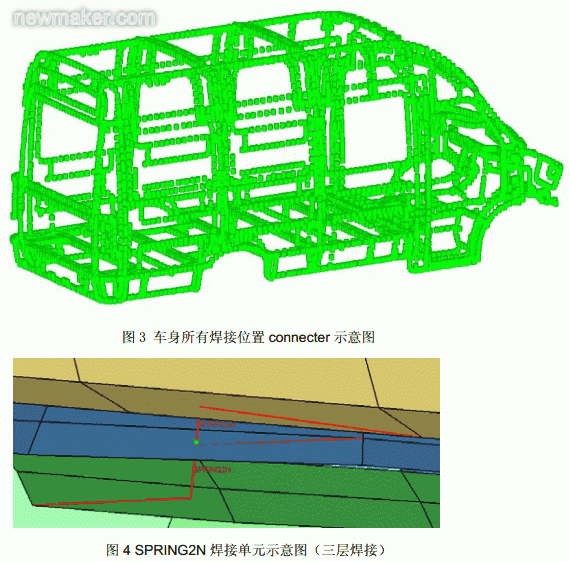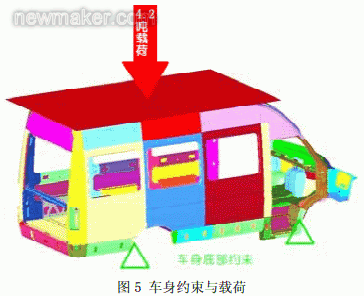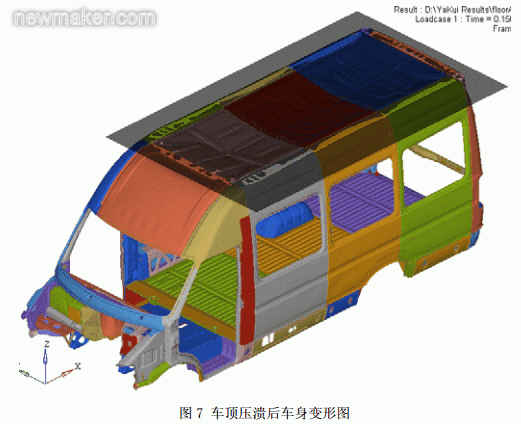In this paper, the body-in-white of a certain model is taken as the research object. According to the requirements of GB 18986-2003 "Structural Safety Requirements for Light Bus", the HyperMesh software is used for pre-processing, and the finite element model of the body-in-white is established, using RADIOSS. The explicit calculation module in the software analyzes the strength of the upper structure of a vehicle body, provides powerful technical support for the body design department, significantly improves the design level, and lays a foundation for subsequent experimental verification. 1 Overview Motor Vehicles Compulsory Certification Implementation Rules No. 01-18 requires that the passenger cars of Class A and Class B single-deck passenger cars (excluding sleeper buses) in Classes M2 and M3 shall comply with GB 18986-2003 "Lightweight passenger car structural safety". Requirements of the requirements; the structure of passenger cars of single-seat passenger cars with more than 22 passengers (with a length of more than 7 meters) shall comply with the requirements of GB 13094-2007 "Safety Requirements for Passenger Cars". Testing the performance of the vehicle through the test requires not only the payment of the test cost, but also the cost of the vehicle itself and the maintenance cost after the test. Therefore, in order to save money, companies prefer to use computer simulation methods. In order to understand the strength of the upper structure of the passenger car of a certain model, the calculation and analysis of the strength of the upper structure of the passenger car is carried out with a certain model, and it is determined according to the calculation result whether it is necessary to carry out the certification test on the actual vehicle. 2 finite element analysis process The material in the upper part strength analysis (similar to the roof crush analysis) must consider the material nonlinearity. This material parameter is obtained by the material tensile test. According to the national standard "GB/T 228-2002 metal material room temperature tensile test method", the main materials of the body body (such as DC03, B170P1, HSA340, etc.) were subjected to tensile test to obtain the stress-strain curve of the body material. The material tensile test is to obtain the nominal stress-strain curve data of the material. The actual stress-strain curve data of the material is needed in the calculation, so the data needs to be processed. The relationship between nominal stress, strain and true stress and strain is: The EXCEL calculation is used to calculate the true stress-strain curve data of the material that can be directly used in the calculation model. The data content is shown in Figure 1. The original white body finite element NASTRAN format model, but this model can not be directly used for RADIOSS collision or crush analysis, need to be modified according to the requirements of the collision model, the main work is as follows: (1) Modify the mesh size. In the collision analysis (explicit calculation), the minimum size of the mesh is required. All the cells whose size check is less than 4mm must be modified. (2) Adjust the mesh model until all parts have no intersection and no material-thickness penetration (see Figure 2); (3) All the welding units in the finite element model whose original format is CWELD are deleted, and the SPRING2N format suitable for the explicit calculation requirements of RADIOSS is generated according to the connector (Fig. 3, Fig. 4). Constraining the installation position of the underbody, the roof uses a rigid large flat plate to load the top of the vehicle body with the maximum design total mass of the vehicle. 3 Analysis results The calculation lasted for 0.15 seconds. It is obvious from the result animation that the white body has completed the maximum yield deformation when it is calculated to about 0.06s, and then 0.09 seconds is repeated in the equilibrium position. The roof was compressed down 52mm by a rigid flat plate. 4 Analysis conclusion Altair's HyperMesh and RADIOSS software were used to simulate the top strength of the car. The analysis showed that the car body deformation was small, and the deformation did not invade the passenger's living space, fully meeting the requirements of the regulations. The technical level of passenger car products has been greatly improved, and the safety of vehicles and passengers will be actively promoted. 5 References [1]Golden Mausoleum. Auto Body Design. Beijing: Mechanical Industry Press, 2008 [2]Altair HyperWorks User's Manual (end) Concerned about surprises Tags: models RADIOSS roof software crush Previous: Oxidation principle and maintenance of zirconia oxygen meter Next: Principle and installation requirements of ultrasonic level gauge Rectangle Chafing Dish,Rectangle Chafing Dishes,Rectangle Chafing Dish With Spring Legs,Mobile Table Ware Shaoxing Biaoyi Hardware Products Co., Ltd. , https://www.byeob.com





